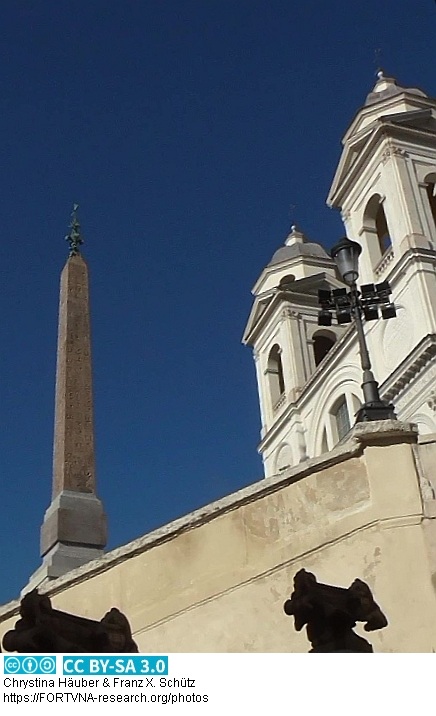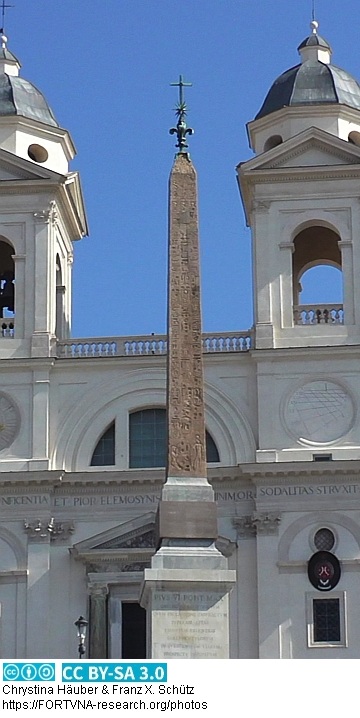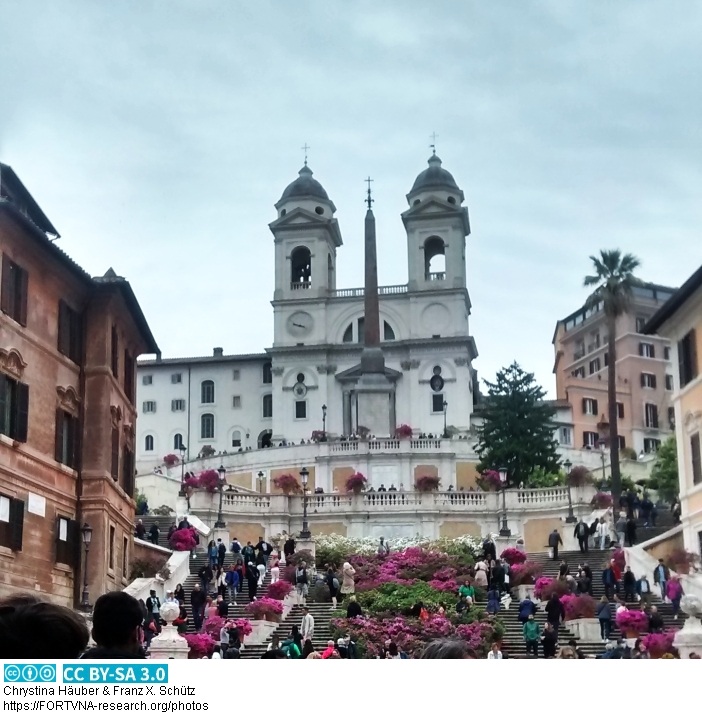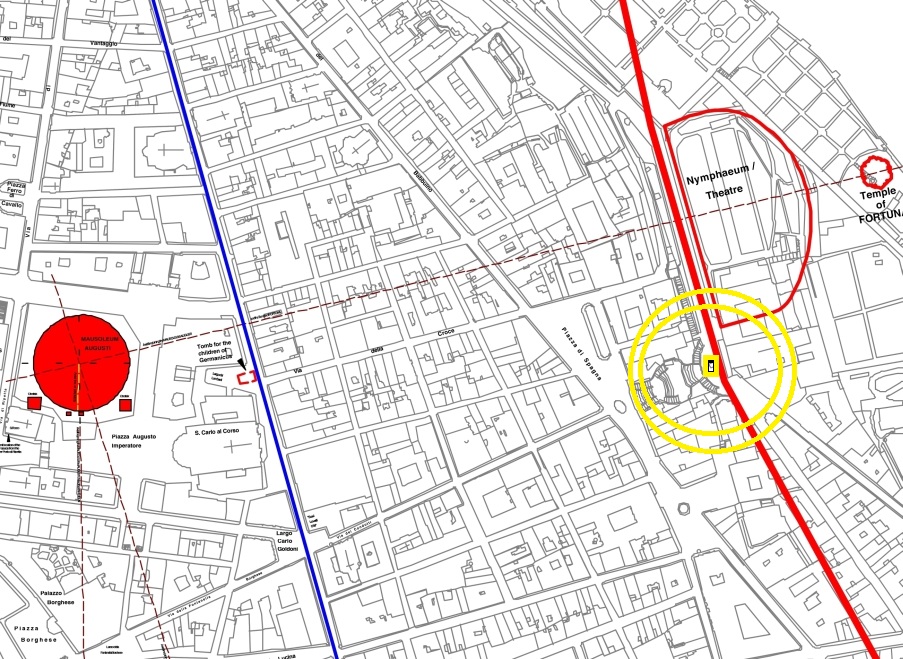
Ägyptischer Obelisk, Rom, Piazza della Trinita dei Monti, "Obelicso Sallustiano"

Am 24.2.2019

Im Oktober 2016

Am 28.5.2016

Mit der "Spanischen Treppe" am 5.5.2022
Text aus FORTVNA PAPERS 2, Chrystina Häuber, Bildunterschrift Seite 114:
"Fig. 4. The obelisk standing in front of the Church of SS. Trinità dei Monti, also known as the `horti Sallustiani obelisk´ and as the `Ludovisi obelisk´.
It is assumed that Aurelian brought this obelisk from Egypt and that he copied Augustus’ concept of placing an obelisk on the spina in the Circus Maximus,
when he erected this obelisk in the horti Sallustiani; cf. ns. 9, 63, and chapters Domitian's Obelisk, the Obeliscus Pamphilius, Appendix 10, VIII. EPILOGUE,
and the Contribution by Vincent Jolivet in this volume"
Seiten 112-113:
When we compare Nolli's representation of the Montecitorio Obelisk with that of the `Ludovisi obelisk´ - as he [Fußnote 52: "
cf. Ehrle 1932, index of Nolli's map: "14 Obelisco Lodovisio giacente".]
called it - the obelisk found in the horti Sallustiani which now stands in front of the Church of SS. Trinità dei Monti [Fußnote 53: "cf. supra, n. 9; G. Cipriani 1982, 47-54, Figs. 27-32: p. 50: "Ed i due pezzi [of the `Ludovisi obelisk´] furono lasciati
dormire lungo il muro della villa Giustiniani nei pressi della Basilica [of S. Giovanni in Laterano] per oltre mezzo secolo ..." (cf. here Fig. 3.4). On p. 54
with fig. 32, the author mentions the Nachleben of this obelisk's base. Cf. J.-C. Grenier, "Obeliscus: Horti Sallustiani", in: LTUR III (1996) 358,
Fig. 219: "Granit d'Assouan; h. 13.90 m ... Les inscriptions hiéroglyphiques qu'il porte sont une reproduction (pénible mais correcte) de celle de l'o.
[beliscus] Augusti in circo Maximo [i.e., the obelisk on the Piazza del Popolo, here Fig. 1.2; cf. Appendix 4, infra, p. 424ff.] (v.[edi]) ... De
forts arguments laissent penser que c'est Aurélien qui voulut ainsi imiter Auguste en amenant d'Egypte, décorant et érigeant cet obélisque
dans un cirque [porticus miliarensis] aménagé sur le flanc E [est] des horti Sallustiani où selon l'Histoire Auguste
(Aurelian 49.1) quotidie et equos et se fatigabat (Grenier)". Grenier, op.cit., mentions also the base of this obelisk. Cf. Habachi 2000, 81-83,
Figs. 70; 72 (here the height of the obelisk 13,91 m is indicated); 84a,b, p. 109, Kat. 8. On p. 83 the author mentions the Nachleben of the obelisk's base.
Kim Hartswick 2004, 52-58, Figs. 2.29-2.33, summarizes the entire history of the `Ludovisi obelisk´, including the Nachleben of its base; p. 55: The obelisk
was broken, as is also visible on his Fig. 2.30 ("Obelisk in the garden of Sallust, engraving, by B. van Overbeke, 1709"); cf. his Figs. 2.32 ("Obelisk base as
monument to the fallen Fascists, 1928"); 2.33 ("Obelisk base on the Capitoline, 2002").
Sylvia Diebner, whom I thank for providing me with a copy of her publication, has studied this part of the obelisk's history in detail:
from 1926-1944 its granite base was reused as "Ara dei caduti per la rivoluzione fascista", erected on the Capitoline Hill, where the base is still to be found
today; cf. ead. 2011, 153-154, p. 155, Fig. 2."] (Fig. 4), both are represented very similarly. Only that
the Ludovisi obelisk, which is almost 14 m high, is shown in Nolli's map as being much smaller than the Montecitorio Obelisk. When Nolli drew his map,
this obelisk lay on the current Piazza di S. Giovanni in Laterano (which, at the time, was much smaller than today!), immediately to the south of the
Villa Giustiniani (see the relevant detail of Nolli's map on Fig. 3.4, labelled: [Villa] Giustiniani; the lying Ludovisi obelisk has the index number 14).
Like the Montecitorio Obelisk, the Ludovisi obelisk was broken (into two pieces), nevertheless Nolli decided to draw also this obelisk's shaft as if it were intact.
Zum download FORTVNA PAPERS 2 und zu den hochauflösenden Karten, vgl. Ausschnitt unten.

Kartenausschnitt mit dem Obelisken (im gelben Doppelkreis), der Rekonstruktion antiker Strukturen und dem aktuellem Stadtgrundriss.
Zu allen georeferenzierten Karten in hoher Auflösung
Go to main page: https://fortvna-research.org/Digitale_Topographie_der_Stadt_Rom/
last update: 4.4.2023
Datenschutzerklärung | Impressum




